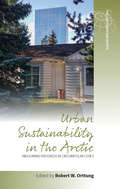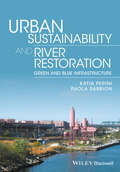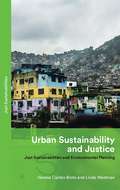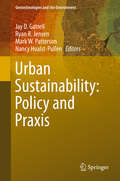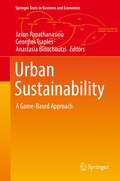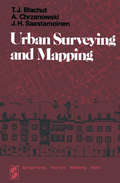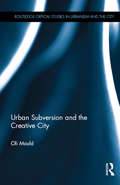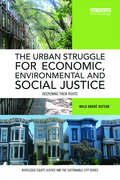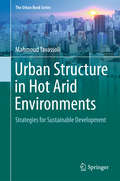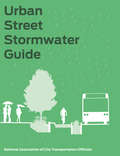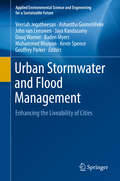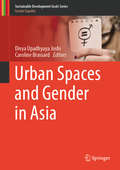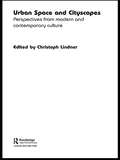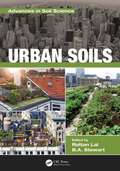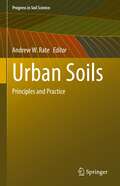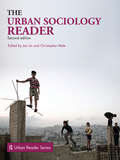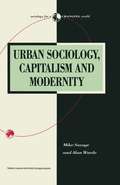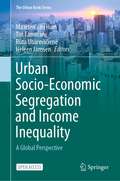- Table View
- List View
Urban Sustainability in the Arctic: Measuring Progress in Circumpolar Cities (Studies in the Circumpolar North #3)
by Robert W. OrttungUrban Sustainability in the Arctic advances our understanding of cities in the far north by applying elements of the international standard for urban sustainability (ISO 37120) to numerous Arctic cities. In delivering rich material about northern cities in Alaska, Canada, and Russia, the book examines how well the ISO 37120 measures sustainability and how well it applies in northern conditions. In doing so, it links the Arctic cities into a broader conversation about urban sustainability more generally.
Urban Sustainability and River Restoration: Green and Blue Infrastructure
by Katia Perini Paola SabbionUrban Sustainability and River Restoration: Green and Blue Infrastructure considers the integration of green and blue infrastructure in cities as a strategy useful for acting on causes and effects of environmental and ecological issues. River restoration projects are unique opportunities for sustainable development and smart growth of communities, providing multiple environmental, economic, and social benefits.This book analyzes initiatives and actions carried out and developed to improve environmental conditions in cities and better understand the environmental impact of (and in) dense urban areas in the United States and in Europe.
Urban Sustainability and River Restoration: Green and Blue Infrastructure
by Katia Perini Paola SabbionUrban Sustainability and River Restoration: Green and Blue Infrastructure considers the integration of green and blue infrastructure in cities as a strategy useful for acting on causes and effects of environmental and ecological issues. River restoration projects are unique opportunities for sustainable development and smart growth of communities, providing multiple environmental, economic, and social benefits.This book analyzes initiatives and actions carried out and developed to improve environmental conditions in cities and better understand the environmental impact of (and in) dense urban areas in the United States and in Europe.
Urban Sustainability and Justice: Just Sustainabilities and Environmental Planning (Just Sustainabilities)
by Vanesa Castán Broto Linda WestmanUrban Sustainability and Justice presents an innovative yet practical approach to incorporate equity and social justice into sustainable development in urban areas, in line with the commitments of the UN's Sustainable Development Goals and the New Urban Agenda. This work proposes a feminist reading of just sustainabilities' principles to reclaim sustainability as a progressive discourse which informs action on the ground. This work will help the committed activist (whether they are on the ground, working in a community, in a non-governmental organization (NGO), in a business, at a university, in any sphere in government) to connect their work to international efforts to deliver environmental justice in cities around the world.Drawing on a comparative, international analysis of sustainability initiatives in over 200 cities, Castán Broto and Westman find limited evidence of the implementation of just sustainabilities principles in practice, but they argue that there is considerable potential to develop a justice-oriented sustainability agenda. Highlighting current successes while also assessing prospects for the future, the authors show that just sustainabilities is not merely an aspirational discourse, but a frame of reference to support radical action on the ground.
Urban Sustainability and Justice: Just Sustainabilities and Environmental Planning (Just Sustainabilities)
by Vanesa Castán Broto Linda WestmanUrban Sustainability and Justice presents an innovative yet practical approach to incorporate equity and social justice into sustainable development in urban areas, in line with the commitments of the UN's Sustainable Development Goals and the New Urban Agenda. This work proposes a feminist reading of just sustainabilities' principles to reclaim sustainability as a progressive discourse which informs action on the ground. This work will help the committed activist (whether they are on the ground, working in a community, in a non-governmental organization (NGO), in a business, at a university, in any sphere in government) to connect their work to international efforts to deliver environmental justice in cities around the world.Drawing on a comparative, international analysis of sustainability initiatives in over 200 cities, Castán Broto and Westman find limited evidence of the implementation of just sustainabilities principles in practice, but they argue that there is considerable potential to develop a justice-oriented sustainability agenda. Highlighting current successes while also assessing prospects for the future, the authors show that just sustainabilities is not merely an aspirational discourse, but a frame of reference to support radical action on the ground.
Urban Sustainability: Praxis And Place (Geotechnologies and the Environment #14)
by Jay D. Gatrell Ryan R. Jensen Mark W. Patterson Nancy Hoalst-PullenThis book explores the environmental, economic, and socio-political dynamics of sustainability from a geographic perspective. The chapters unite the often disparate worlds of environment, economics, and politics by seeking to understand and visualize a range of sustainability practices on the ground and in place. In concert, the book provides an overview of a range of geotechnical applications associated with environmental change (water resources, land use & land cover change); as well as investigates more nuanced and novel examples of local economic development in cities. The diverse collection maps local practices from urban farming to evolving and thriving industries such as metal scrapping and craft beer. Additionally, the book provides an integrated geo-technical framework for understanding and assessing ecosystem services, explores the deployment of unmanned systems to understand urban environmental change, interrogates the spatial politics of urban green movements, examines the implications of revised planning practices, and investigates environmental justice. The book will be of interest to researchers, students, and anyone seeking to better understand sustainability at multiple scales in urban environments.
Urban Sustainability: A Game-Based Approach (Springer Texts in Business and Economics)
by Jason Papathanasiou Georgios Tsaples Anastasia BlouchoutziThis textbook provides an innovative pedagogy to students who will be the policy makers of tomorrow. It provides thoughts on sustainability and the complexity among its different dimensions. It guides students through experience, processes of complex decision making, and sharpen their clarity of thought, to enhance their communication abilities and help them develop critical thinking. It provides key competencies to address the complexities of sustainable development.By combining game-based learning with an analytical style of education, supplemental materials are provided to make the definitions of various sustainability aspects more concrete and allows students to experiment in a consequence-free environment, with scenario examples. Board Game and a hypothetical management course, dealing with various topics like transportation sustainability, societal metabolism, etc. as well as with decision making under those contexts, will formalize the mathematics needed to make robust decisions.
Urban Surveying and Mapping
by T. J. Blachut A. Chrzanowski J. H. SaastamoinenThe idea of writing a textbook on urban surveying and mapping originated with the Commission on Cartography of the Pan American Institute of Geography and History (PAIGH) because of the urgent need for planned and integrated surveying and mapping in urban communities of the American Hemisphere. It is obvious, however, that, with the exception of some European countries, the same situation exists in most cities of the world. The undersigned was asked to undertake the task. The task was not simple. The only available comprehensive text in the field 1 is Geodezja Miejska , which was published recently in Poland and reached the authors only after most of the present text was written. It is tailored to a very specific market and different requirements. Although it is an impressive book, it differs vastly from our own approach. Other reference texts are fragmentary or obsolete. During the last two decades, revolutionary changes have occurred in survey ing and mapping technology which have had a profound effect on actual procedures. In addition, the traditional concepts of urban surveying and map ping are undergoing rapid evolution. It is recognized that administration and planning require a great variety of continuously updated information which must be correlated with the actual physical fabric of the community, as de termined by surveying and mapping. Modern urban surveying and mapping is therefore the foundation of the broad and dynamic information system that is indispensable in any rational municipal effort.
Urban Subversion and the Creative City (Routledge Critical Studies in Urbanism and the City)
by Oli MouldCheck out the author's video to find out more about the book: https://vimeo.com/124247409 This book provides a comprehensive critique of the current Creative City paradigm, with a capital ‘C’, and argues for a creative city with a small ‘c’ via a theoretical exploration of urban subversion. The book argues that the Creative City (with a capital 'C') is a systemic requirement of neoliberal capitalist urban development and part of the wider policy framework of ‘creativity’ that includes the creative industries and the creative class, and also has inequalities and injustices in-built. The book argues that the Creative City does stimulate creativity, but through a reaction to it, not as part of it. Creative City policies speak of having mechanisms to stimulate individual, collective or civic creativity, yet through a theoretical exploration of urban subversion, the book argues that to be 'truly' creative is to be radically different from those creative practices that the Creative City caters for. Moreover, the book analyses the role that urban subversion and subcultures have in the contemporary city in challenging the dominant political economic hegemony of urban creativity. Creative activities of people from cities all over the world are discussed and critically analysed to highlight how urban creativity has become co-opted for political and economic goals, but through a radical reconceptualisation of what creativity is that includes urban subversion, we can begin to realise a creative city (with a small 'c').
Urban Subversion and the Creative City (Routledge Critical Studies in Urbanism and the City)
by Oli MouldCheck out the author's video to find out more about the book: https://vimeo.com/124247409 This book provides a comprehensive critique of the current Creative City paradigm, with a capital ‘C’, and argues for a creative city with a small ‘c’ via a theoretical exploration of urban subversion. The book argues that the Creative City (with a capital 'C') is a systemic requirement of neoliberal capitalist urban development and part of the wider policy framework of ‘creativity’ that includes the creative industries and the creative class, and also has inequalities and injustices in-built. The book argues that the Creative City does stimulate creativity, but through a reaction to it, not as part of it. Creative City policies speak of having mechanisms to stimulate individual, collective or civic creativity, yet through a theoretical exploration of urban subversion, the book argues that to be 'truly' creative is to be radically different from those creative practices that the Creative City caters for. Moreover, the book analyses the role that urban subversion and subcultures have in the contemporary city in challenging the dominant political economic hegemony of urban creativity. Creative activities of people from cities all over the world are discussed and critically analysed to highlight how urban creativity has become co-opted for political and economic goals, but through a radical reconceptualisation of what creativity is that includes urban subversion, we can begin to realise a creative city (with a small 'c').
The Urban Struggle for Economic, Environmental and Social Justice: Deepening their roots (Routledge Equity, Justice and the Sustainable City series)
by Malo André HutsonThis book discusses the current demographic shifts of blacks, Latinos, and other people of colour out of certain strong-market cities and the growing fear of displacement among low-income urban residents. It documents these populations’ efforts to remain in their communities and highlights how this leads to community organizing around economic, environmental, and social justice. The book shows how residents of once-neglected urban communities are standing up to city economic development agencies, influential real estate developers, universities, and others to remain in their neighbourhoods, protect their interests, and transform their communities into sustainable, healthy communities. These communities are deploying new strategies that build off of past struggles over urban renewal. Based on seven years of research, this book draws on a wealth of material to conduct a case study analysis of eight low-income/mixed-income communities in Boston, New York, San Francisco, and Washington, DC. This timely book is aimed at researchers and postgraduate students interested in urban policy and politics, community development, urban studies, environmental justice, urban public health, sociology, community-based research methods, and urban planning theory and practice. It will also be of interest to policy makers, community activists, and the private sector.
The Urban Struggle for Economic, Environmental and Social Justice: Deepening their roots (Routledge Equity, Justice and the Sustainable City series)
by Malo André HutsonThis book discusses the current demographic shifts of blacks, Latinos, and other people of colour out of certain strong-market cities and the growing fear of displacement among low-income urban residents. It documents these populations’ efforts to remain in their communities and highlights how this leads to community organizing around economic, environmental, and social justice. The book shows how residents of once-neglected urban communities are standing up to city economic development agencies, influential real estate developers, universities, and others to remain in their neighbourhoods, protect their interests, and transform their communities into sustainable, healthy communities. These communities are deploying new strategies that build off of past struggles over urban renewal. Based on seven years of research, this book draws on a wealth of material to conduct a case study analysis of eight low-income/mixed-income communities in Boston, New York, San Francisco, and Washington, DC. This timely book is aimed at researchers and postgraduate students interested in urban policy and politics, community development, urban studies, environmental justice, urban public health, sociology, community-based research methods, and urban planning theory and practice. It will also be of interest to policy makers, community activists, and the private sector.
Urban Structure in Hot Arid Environments: Strategies for Sustainable Development (The Urban Book Series)
by Mahmoud TavassoliThis essential reference guide to strategies and solutions for urban planning in hot arid environments reflects the journey toward many cities, towns and villages in Iran, which are documented and presented in the form of case studies and comparative analysis. It is the outcome of extensive research on the influence of historical, cultural and climatic factors on urban spatial forms and rural complexes in Iran’s Hot Arid Zone.The environment of the Hot Arid Zone offers valuable insights into how to overcome historical difficulties, how to endure harsh climatic conditions, how to be innovative and creative in responding to problems in new ways, and how to utilize natural energy sources. Considerable attention is given to the recognition of values, current problems and the renewal of traditional fabrics, urban blocks and traditional buildings. Important aspects in both academic education and in the urban design profession include traditional urban structures and traditional approaches to using natural energy as a creative process that is continuously changing and renews itself over time – a dynamic characteristic from which we can glean many lessons for the future.This book is based on a book previously published by the author in Persian. This version is an extensively revised version.
Urban Street Stormwater Guide
by NACTOThe state-of-the-art solutions in this guide will assist urban planners and designers, transportation engineers, city officials, ecologists, public works officials, and others interested in the role of the built urban landscape in protecting the climate, water quality, and natural environment.
Urban Stormwater and Flood Management: Enhancing the Liveability of Cities (Applied Environmental Science and Engineering for a Sustainable Future)
by Veeriah Jegatheesan Ashantha Goonetilleke John Van Leeuwen Jaya Kandasamy Doug Warner Baden Myers Muhammed Bhuiyan Kevin Spence Geoffrey ParkerThis book brings together the experiences of engineers and scientists from Australia and the United Kingdom providing the current status on the management of stormwater and flooding in urban areas and suggesting ways forward. It forms a basis for the development of a framework for the implementation of integrated and optimised storm water management strategies and aims to mitigate the adverse impacts of the expanding urban water footprint. Among other topics it also features management styles of stormwater and flooding and describes biodiversity and ecosystem services in relation to the management of stormwater and the mitigation of floods. Furthermore, it places an emphasis on sustainable storm water management measures. Population growth, urbanisation and climate change will pose significant challenges to engineers, scientists, medical practitioners, policy makers and practitioners of several other disciplines. If we consider environmental and water engineers, they will have to face challenges in designing smart and efficient water systems which are robust and resilient to overcome shrinking green spaces, increased urban heat islands, damages to natural waterways due to flooding caused by increased stormwater flow. This work provides valuable information for practitioners and students at both senior undergraduate and postgraduate levels.
Urban Spaces and Gender in Asia (Sustainable Development Goals Series)
by Caroline Brassard Divya Upadhyaya JoshiExploring the relationship between place and identity, this book gathers 30 papers that highlight experiences from throughout the Asia-Pacific region. The countries profiled include China, India, Japan, Indonesia, and Thailand. Readers will gain a better understanding of how urbanization is affecting gender equity in Asian-Pacific cities in the 21st century. The contributing authors examine the practical implications of urban development and link them with the broader perspective of urban ecology. They consider how visceral experiences connect with structural and discursive spheres. Further, they investigate how multiple, interconnected relations of power shape gender (in)equity in urban ecologies, and address such issues as construction of Kawaii as an idealized femininity, diversity among homosexuals in urban India, and single women and rental housing. In turn, the authors present hitherto unexplored sub-themes from historiography and existentialist literary perspectives, and share a vast range of multi-disciplinary views on issues concerning gendered dispossession due to the impact of urban policy and governance. The topics covered include socio-spatial and ethnic segregation in urban spaces; intersections of gender, race, ethnicity, nationality, religion, and caste in urban spaces; and identity-based marginalization, including that of LGBT groups. Overall, the book brings together perspectives from the humanities and the social sciences, and represents a valuable contribution to the vital theoretical and practical debates on urbanism and gender equity.
Urban Space and Cityscapes: Perspectives from Modern and Contemporary Culture
by Christoph LindnerFrom the verticals of New York, Hong Kong and Singapore to the sprawls of London, Paris and Jakarta, this interdisciplinary volume of new writing examines constructions, representations, imaginations and theorizations of 'cityscapes' in modern and contemporary culture. With specially-commissioned essays from the fields of cultural theory, architecture, film, literature, visual art and urban geography, it offers fresh insight into the increasingly complex relationship between urban space, cultural production and everyday life. This volume draws on critical urban studies and moves beyond familiar cultural representations of the city by considering urban planning and architecture. Organized under three inter-related themes - image, text and form - essay topics range from the examination of cyberpunk skylines, pagan urbanism and the cinema of urban disaster, to the analysis of iconic city landmarks such as the twin towers, the London Eye and the Judisches Museum Berlin. Covering a diverse range of cities, including Berlin, Chicago, Jakarta, Johannesburg, Hong Kong, London, Los Angeles, Paris, and Venice, this fantastic resource for students, scholars and researchers alike, works expertly at the intersections of visual, material, and literary culture.
Urban Space and Cityscapes: Perspectives from Modern and Contemporary Culture
by Christoph LindnerFrom the verticals of New York, Hong Kong and Singapore to the sprawls of London, Paris and Jakarta, this interdisciplinary volume of new writing examines constructions, representations, imaginations and theorizations of 'cityscapes' in modern and contemporary culture. With specially-commissioned essays from the fields of cultural theory, architecture, film, literature, visual art and urban geography, it offers fresh insight into the increasingly complex relationship between urban space, cultural production and everyday life. This volume draws on critical urban studies and moves beyond familiar cultural representations of the city by considering urban planning and architecture. Organized under three inter-related themes - image, text and form - essay topics range from the examination of cyberpunk skylines, pagan urbanism and the cinema of urban disaster, to the analysis of iconic city landmarks such as the twin towers, the London Eye and the Judisches Museum Berlin. Covering a diverse range of cities, including Berlin, Chicago, Jakarta, Johannesburg, Hong Kong, London, Los Angeles, Paris, and Venice, this fantastic resource for students, scholars and researchers alike, works expertly at the intersections of visual, material, and literary culture.
Urban Soils (Advances in Soil Science)
by Rattan Lal B. A. StewartGlobally, 30% of the world population lived in urban areas in 1950, 54% in 2016 and 66% projected by 2050. The most urbanized regions include North America, Latin America, and Europe. Urban encroachment depletes soil carbon and the aboveground biomass carbon pools, enhancing the flux of carbon from soil and vegetation into the atmosphere. Thus, urbanization has exacerbated ecological and environmental problems. Urban soils are composed of geological material that has been drastically disturbed by anthropogenic activities and compromised their role in the production of food, aesthetics of residential areas, and pollutant dynamics. Properties of urban soils are normally not favorable to plant growth—the soils are contaminated by heavy metals and are compacted and sealed. Therefore, the quality of urban soils must be restored to make use of this valuable resource for delivery of essential ecosystem services (e.g., food, water and air quality, carbon sequestration, temperature moderation, biodiversity). Part of the Advances in Soil Sciences Series, Urban Soils explains properties of urban soils; assesses the effects of urbanization on the cycling of carbon, nitrogen, and water and the impacts of management of urban soils, soil restoration, urban agriculture, and food security; evaluates ecosystem services provisioned by urban soils, and describes synthetic and artificial soils.
Urban Soils (Advances in Soil Science)
by Rattan Lal B. A. StewartGlobally, 30% of the world population lived in urban areas in 1950, 54% in 2016 and 66% projected by 2050. The most urbanized regions include North America, Latin America, and Europe. Urban encroachment depletes soil carbon and the aboveground biomass carbon pools, enhancing the flux of carbon from soil and vegetation into the atmosphere. Thus, urbanization has exacerbated ecological and environmental problems. Urban soils are composed of geological material that has been drastically disturbed by anthropogenic activities and compromised their role in the production of food, aesthetics of residential areas, and pollutant dynamics. Properties of urban soils are normally not favorable to plant growth—the soils are contaminated by heavy metals and are compacted and sealed. Therefore, the quality of urban soils must be restored to make use of this valuable resource for delivery of essential ecosystem services (e.g., food, water and air quality, carbon sequestration, temperature moderation, biodiversity). Part of the Advances in Soil Sciences Series, Urban Soils explains properties of urban soils; assesses the effects of urbanization on the cycling of carbon, nitrogen, and water and the impacts of management of urban soils, soil restoration, urban agriculture, and food security; evaluates ecosystem services provisioned by urban soils, and describes synthetic and artificial soils.
Urban Soils: Principles and Practice (Progress in Soil Science)
by Andrew W. RateThis textbook addresses the increasing trend in urbanization of the world’s population and its relation with urban soils. Written by active practitioners of university level teaching and research, this book is designed primarily as an educational text, while it also provides readers with an authoritative gateway to the primary literature. It includes explicit coverage of spatial and statistical (multivariate) techniques and case studies to illustrate key concept, and to support practical guidance in issues such as data collection and analysis. The authors reflect current developments in research and urban trends. In China, for example, the proportion of the population living in cities increased from 13% in 1950 to 45% in 2010 (World Bank data). Australia is one of the world's top ten urbanised countries with population greater than ten million, with approximately 90% of its population living in cities, mainly along Australia's coast. The most rapidly urbanising populations are currently in nations of the African continent. Soils in urban areas have multiple functions which are becoming more valued by urban communities: soils supply water, nutrients and physical support for urban plant and animal communities (parks, reserves, gardens), and are becoming increasingly valued for growing food. Soils may be used for building foundations, or as building materials themselves. Urban hydrology relies on the existence of unsealed soils for aquifer protection and flood control. This volume presents the importance of urban ecosystems and the impacts of global change. It examines pedogenesis of urban soils: natural materials affected by urban phenomena, and natural processes acting on urban materials, including an examination of different climatic zones. There is a focus on soils formed on landfill, reclaimed land, dredge spoils as well as soil-related changes in urban geomorphology. There is plenty of discussion on urban soil as a source and sink as well as soil geochemistry and health. The book is intended primarily as a text for upper-level undergraduate, and postgraduate (Masters) students. It will also be invaluable as a resource for professionals such as researchers, environmental regulators, and environmental consultants.
The Urban Sociology Reader (Routledge Urban Reader Series)
by Jan Lin Christopher MeleThe urban world is an exciting terrain for investigating the central institutions, structures and problems of the social world and how they have transformed through the last 200 years. This Reader comprises sections on urban social theory, racial and social difference in the city, culture in everyday life, culture and the urban economy, globalization and transnational social relations and the regulation of urban space. Drawing together seminal selections covering the nineteenth to the twenty-first centuries, this Reader includes forty-three significant writings from eminent names such as Simmel, Wirth, Park, Burgess, DuBois, Zukin, Sassen, and Harvey. The 2nd edition illuminates more recent urban issues such as sprawl, sustainability, immigration and urban protest. Selections are predominantly sociological, but some readings cross disciplinary boundaries. Providing an essential resource for students of urban studies, this book brings together important but, till now, widely dispersed writings. Editorial commentaries precede each entry; introducing the text, demonstrating its significance, and outlining the issues surrounding its topic, whilst the associated bibliography enables deeper investigations.
The Urban Sociology Reader (Routledge Urban Reader Series)
by Jan Lin Christopher MeleThe urban world is an exciting terrain for investigating the central institutions, structures and problems of the social world and how they have transformed through the last 200 years. This Reader comprises sections on urban social theory, racial and social difference in the city, culture in everyday life, culture and the urban economy, globalization and transnational social relations and the regulation of urban space. Drawing together seminal selections covering the nineteenth to the twenty-first centuries, this Reader includes forty-three significant writings from eminent names such as Simmel, Wirth, Park, Burgess, DuBois, Zukin, Sassen, and Harvey. The 2nd edition illuminates more recent urban issues such as sprawl, sustainability, immigration and urban protest. Selections are predominantly sociological, but some readings cross disciplinary boundaries. Providing an essential resource for students of urban studies, this book brings together important but, till now, widely dispersed writings. Editorial commentaries precede each entry; introducing the text, demonstrating its significance, and outlining the issues surrounding its topic, whilst the associated bibliography enables deeper investigations.
Urban Sociology, Capitalism and Modernity (Sociology for a Changing World)
by Michael Savage Alan WardeThis text seeks to defend the achievements of urban sociology and its contribution to evaluating theories of the nature and implications of both capitalism and modernity. The book reviews the history of urban sociology, theories of uneven development, studies of urban inequalities, analyses of urban culture and meaning and urban politics. It argues that urban sociology can be conceived as an extended empirical inquiry into the nature of capitalist modernity.
Urban Socio-Economic Segregation and Income Inequality: A Global Perspective (The Urban Book Series)
by Maarten Van Ham Tiit Tammaru Rūta Ubarevičienė Heleen JanssenThis open access book investigates the link between income inequality and socio-economic residential segregation in 24 large urban regions in Africa, Asia, Australia, Europe, North America, and South America. It offers a unique global overview of segregation trends based on case studies by local author teams. The book shows important global trends in segregation, and proposes a Global Segregation Thesis.Rising inequalities lead to rising levels of socio-economic segregation almost everywhere in the world. Levels of inequality and segregation are higher in cities in lower income countries, but the growth in inequality and segregation is faster in cities in high-income countries. This is causing convergence of segregation trends. Professionalisation of the workforce is leading to changing residential patterns. High-income workers are moving to city centres or to attractive coastal areas and gated communities, while poverty is increasingly suburbanising. As a result, the urban geography of inequality changes faster and is more pronounced than changes in segregation levels. Rising levels of inequality and segregation pose huge challenges for the future social sustainability of cities, as cities are no longer places of opportunities for all.
